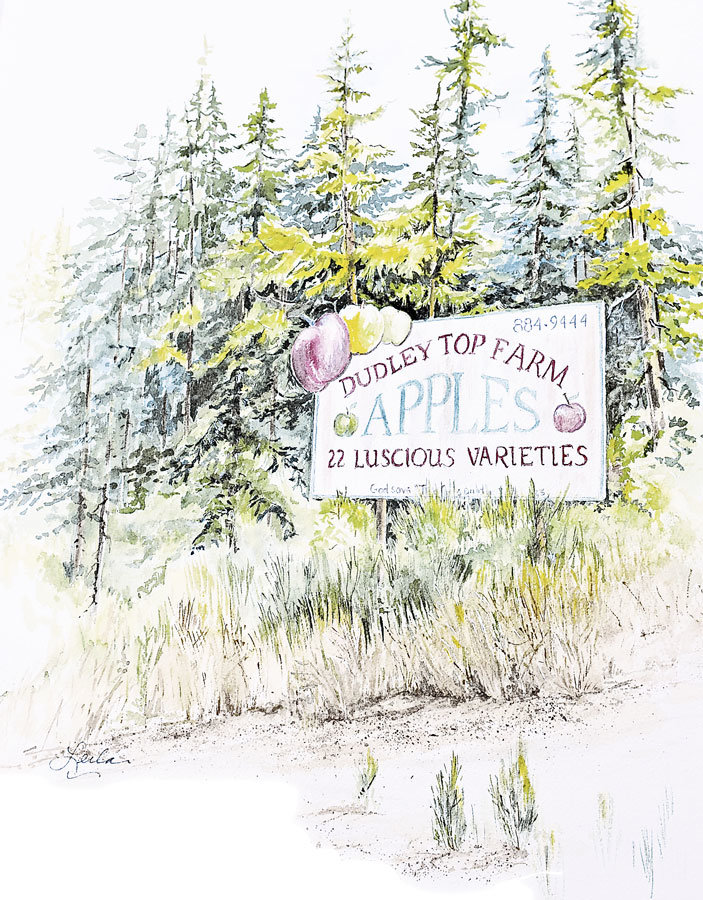
People of the Key Peninsula love their orchards, as evidenced by the apple trees growing everywhere. Historically, most apples on the Key Peninsula were grown for private use.
Tim Kezele grew up on Joe’s Bay where the family had a small orchard. “An old guy from the California Dust Bowl migration taught me to prune when I was a kid,” he said. Despite a good supply of apples of their own, his mom took him to abandoned plum and apple trees near the current Evergreen Elementary School location to forage. “We climbed over blackberry vines and got a lot of fruit,” he said. “Mom didn’t want anything to go to waste.”
Claudia Loy’s grandparents lived in Longbranch near the end of the highway. “Every spring they hosted a guy who came here with bare root trees. He worked his way down the peninsula selling stock to all the homesteaders,” she said.
Over the years Kezele has pruned and restored many fruit trees in the area. He loves what he refers to as an old growth Gravenstein in Home, so tall and glorious that “it will give you nosebleeds.” He has a few favorite abandoned orchards as well. “When the leaves are off and there are the silhouettes and the horizon, it’s beautiful,” he said. “There is an old shed back there but I don’t know who owns it. I’ve always wanted to prune it. Cattle ran through it at one time.”
Apples were mostly grown for personal use, but there were a few exceptions. Cathie Tritle Christie grew up on her family farm in Longbranch. About 10 acres were planted in apples, mostly Gravensteins and a few Kings. They sold to Hogan’s and Thriftway and had a U-pick option. Russell Tritle started with peaches. “Someone said that peaches wouldn’t do well here, and that got my dad started,” she said. “The peaches did will until they were taken out by blight. Then he switched to apples.”
Customers picked their own fruit. In addition to apples, they had 6,000 laying hens, some cattle and other produce. They sold and traded with neighbors. “We had a jar for money and people traded what they thought was fair. It worked well,” she said.
In 1999 Barb Schoos and her husband Scott Reichard bought the property. They pruned a few of the trees but Schoos said that most of the trees are probably more valuable as habitat for wildlife now. They pick for pies and applesauce, supply some neighbors with apples to feed livestock, and sometimes supply apples to a cider operation. The money jar still sits in the old henhouse as a reminder of an era now past.
Dudley Top Apple Farm was perhaps the best known to the Key Peninsula community. It was owned by Kyle Chapman, a general surgeon, and his wife Addy. Chapman’s family purchased the 124-acre parcel in 1908. Much of the land was undeveloped, but he planted 13 acres in apples. According to an article in the KP News (“The Passions of Dr. Chapman,” KP News Dec. 2003) there were 25 varieties. Chapman said that state regulations curtailed his hopes for making the operation a commercial success. He died in 2013.
The Chapman property was divided and sold. Tristan Lester and his wife, who have two young daughters, purchased the parcel that included the Chapman home and orchard last November. Lester said he has spent the last six months clearing barbed wire fencing, scotch broom and blackberries from around the trees.
“Some trees were beyond saving,” he said. “But the trees that are doing well produced a lot of fruit. We shared some with neighbors and made a lot of applesauce.” They hope to restore the orchard and are thinking about options to manage the produce such as a roadside stand or food bank donations.
UNDERWRITTEN BY THE FUND FOR NONPROFIT NEWS (NEWSMATCH) AT THE MIAMI FOUNDATION, THE ANGEL GUILD, ADVERTISERS, DONORS AND PEOPLE WHO SUPPORT INDEPENDENT, NONPROFIT LOCAL NEWS